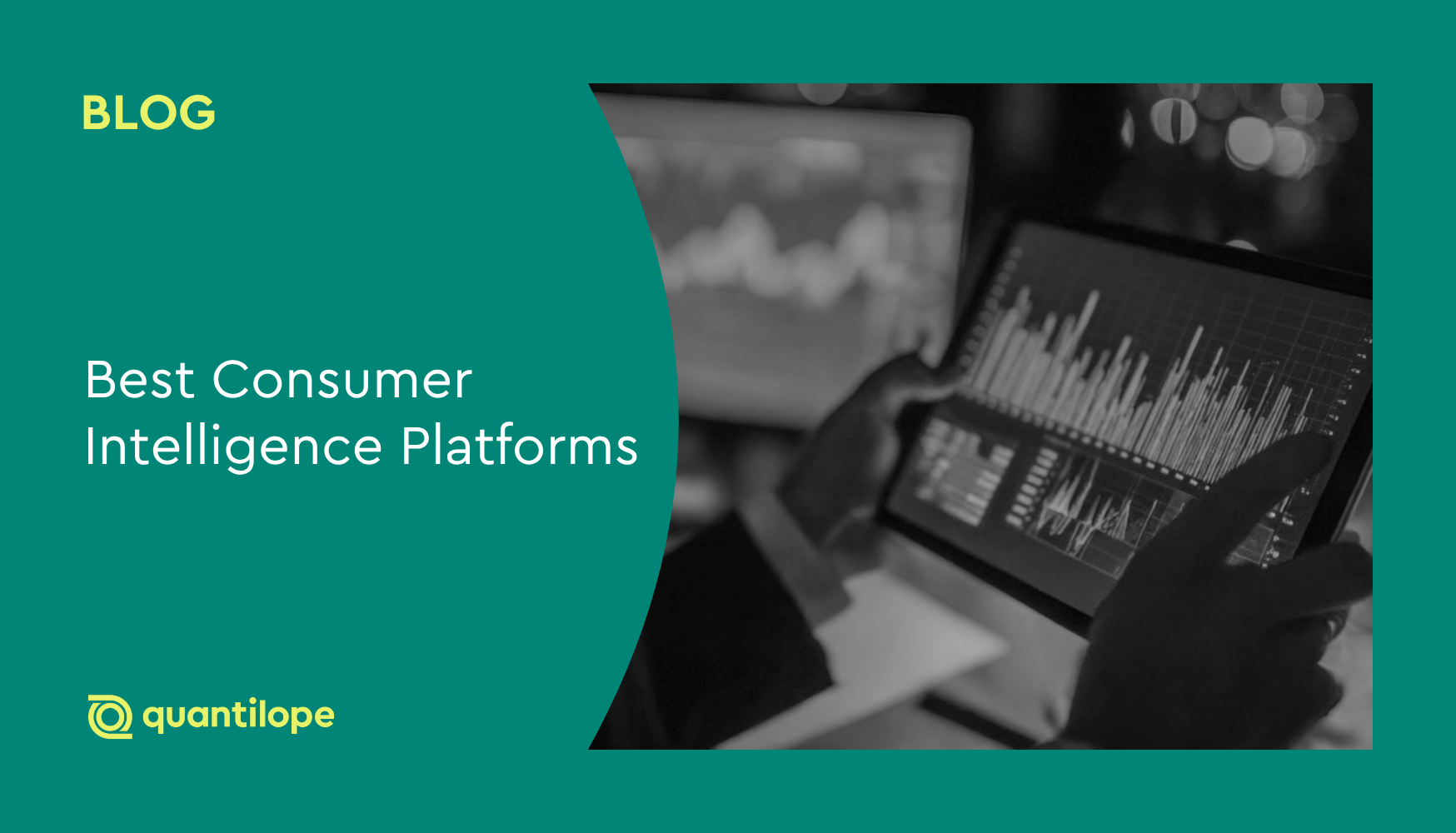This blog explores how to leverage advanced method research and a tracking research approach to gain ongoing insights that are complex and actionable. Using each of these research approaches together sets your business up for long-term success.
Table of Contents:
- Understanding modern market research challenges
- Integrated platform research
- Advanced research methods: Beyond basic consumer insights
- Modern tracking research: beyond traditional brand metrics
- Leveraging advanced methods alongside tracking projects
- quantilope's Consumer Intelligence Platform: Tracking advanced methods insights
Understanding modern market research challenges
Today, research teams are tasked with gathering more insights, at a faster speed, often without increased budget or resources. Traditional means of research struggle to keep up with these demands, often requiring multiple siloed teams which lead to lengthy timelines and steep project costs. This translates to delayed (and sometimes lower quality) insights along with potential missed opportunities. Traditional research agencies also make collaborative research difficult, with version control issues and team-specific timelines, let alone higher costs that limit the number of projects a research team can run.
For teams looking for one centralized platform for their advanced consumer insights, an end-to-end automated platform will allow for a faster, more efficient research approach.
Back to Table of Contents
Integrated platform research
Automated research platforms solve a lot of the issues that come with traditional agencies. An integrated research platform empowers businesses to conduct research with exceptional speed and efficiency, enabling rapid responses to dynamic market conditions. Access to real-time data and automated analyses facilitate informed decision-making within shortened timeframes. The ability to easily adapt research methodologies and target specific audience segments ensures that insights are relevant and actionable, even as the market shifts.
Consolidating research tools and data sources within an integrated consumer insights platform also often reduces operational expenses and optimizes resource allocation. Teams are able to collaborate in one end-to-end platform for everything from survey setup to panel recruitment and reporting/dashboard creation. Automated processes and streamlined workflows minimize manual effort, freeing up researchers to focus on strategic analysis and data interpretation.
By delivering actionable insights that directly contribute to business growth, an integrated research platform provides a demonstrable return on investment (ROI), justifying its value and securing ongoing support. In the sections below, we’ll explore how leveraging advanced methods and tracking projects within these platforms can contribute to much more actionable and informed business decisions.
Back to Table of Contents
Advanced research methods: Beyond basic consumer insights
Advanced research methods enable organizations to transcend basic consumer insights like yes/no questions and Likert scales to develop more sophisticated and effective marketing strategies. There are many types of advanced methods, each solving a different business need through behavioral and research science to understand why and how consumers make decisions.
quantilope's advanced methodologies for strategic decision-making
quantilope offers the largest suite of advanced methods. Below is a short summary on how to leverage each advanced method for strategic business decisions that go beyond standard consumer insights.
A/B Testing (Monadic + Pre-Roll)
Use A/B testing to directly compare the performance of different marketing messages, product features, or advertising collateral. Using an A/B test allows brands to optimize campaigns and new product development efforts to help ensure you bring the right one to market. A/B pre-roll testing specifically allows brands to optimize video content before launch.
Choice-based Conjoint analysis
A Choice-based Conjoint analysis helps brands understand how consumers value different product or service attributes. Respondents will see various configurations of products or services, each with different specific attributes such as price, color, material, size, etc. This enables businesses to test which specific configuration most closely aligns with customer preferences, thereby maximizing market potential.
Implicit Association Testing (Single and Multi-)
Leverage a Single Implicit Association Test (SIAT) to uncover unconscious biases and associations toward a single brand, product, or category. Multi Implicit Association Tests (MIAT) are similar, but allow for the comparison of multiple brands or attributes. Measuring these underlying preferences reveals hidden drivers of brand perception and purchase decisions, leading to more effective marketing and branding strategies.
Key Driver analysis
Key Driver Analysis (KDA) identifies the most influential factors driving outcomes such as customer satisfaction, brand loyalty, or purchase decisions. Using KDA insights allow you to prioritize the right resources and strategic initiatives that will maximize business impact.
MaxDiff analysis
Use a MaxDiff analysis to determine the relative importance of different product features, brand attributes, or marketing messages. Using a MaxDiff enables brands to develop targeted strategies that focus on the most impactful element(s) (rather than being left with data where consumers say ‘everything is important’). The quantilope Academy's MaxDiff course walks through this advanced method in more detail.
Mental Advantage analysis
As part of quantilope's Better Brand Health Tracking approach, Mental Advantage analysis assesses a brand's competitive position in the minds of consumers by measuring performance relative to expectations – given the brand's size and how 'prototypical' the measured attributes are for the category as a whole (e.g. 'for energy' is pretty 'prototypical' for the coffee category, so we'd expect most coffee brands to perform well for this attribute). Understanding which brands have Mental Advantages/Disadvantages (or where no brands currently have an Advantage yet) reveals actionable opportunities to strengthen certain brand associations or expand into certain Category Entry Points.
Mental Availability analysis
Also part of Better Brand Health Tracking projects, Mental Availability analysis measures the likelihood that consumes consider a specific brand in certain purchase scenarios (aka, Category Entry Points). Mental Availability stems from four key metrics: Mental Market Share, Mental Penetration, Network Size, and Share of Mind; more on those metrics here.
Net Promoter Score
Net Promoter Score (NPS) gauges customer loyalty and advocacy through a set scoring system, identifying consumers as either brand 'Promoters' or 'Detractors' on each end of the scale. Leveraging NPS helps brands understand their customer experience. If NPS is low, the brand will want to work on strategies that increase positive word-of-mouth (i.e. your 'Promoters').
Penalty Reward/KANO Factors
Often used together with a KDA, Penalty Reward/KANO factors analysis explores the type of correlation between features and outcomes, such as overall customer satisfaction. Results from a Penalty Reward/KANO analysis can be helpful in informing product development decisions and prioritizing features that drive customer delight.
Price Sensitivity Meter
A Price Sensitivity Meter (PSM) analysis (also known as a Van Westendorp analysis) determines the optimal price range for a product or service, maximizing revenue and profitability by aligning pricing with customers' willingness to pay. It uses a set series of four pricing questions, asking respondents their perceptions around what price they consider expensive/cheap. Learn more about how price sensitivity affects consumer behavior.
Total Unduplicated Reach and Frequency analysis
Total Unduplicated Reach and Frequency (TURF) analysis is used to optimize product assortments or marketing campaigns. TURF identifies the combination of elements that reaches the largest possible audience without duplicating efforts, thereby maximizing market reach and minimizing redundancy.
Segmentation
quantilope leverages a Need-based Segmentation analysis to identify distinct customer groups based on their true needs. In doing so, brands can develop targeted marketing strategies and personalized customer experiences that generate real impact.
qualitative inColor
quantilope’s qualitative video solution, inColor, allows researchers to gain rich, contextual insights into consumer emotions, sentiments, and perceptions. inColor insights facilitate a deeper understanding of customers through verbal feedback and visual body language. Many researchers use inColor in conjunction with quantitative research questions to support their overall research findings.
Back to Table of Contents
Modern tracking research: beyond traditional brand metrics
Traditional brand tracking approaches have benefited businesses for decades, providing them with valuable insight into their brand health. However, businesses today can no longer stay competitive with lengthy tracking turnaround times and limited brand metrics to take action from.
Modern businesses are solving these traditional brand tracking obstacles by turning to automated market research platforms with improved brand tracking approaches.
Automated brand tracking
Automated research platforms speed up the time to tracking insights by bypassing the need for various teams, each with their own timelines. Brands no longer need to draft their questionnaire in a color-coded document (bound for version control issues), wait for a programming team to set up their survey, rely on a data processing team to send preliminary and final insights, or input final metrics by hand into a shareable report (again, bound for version control issues).
Brands today can avoid all these lengthy turnaround times and costs per siloed team by housing their entire project on one end-to-end automated platform like quantilope. These platforms are built on efficiency, replacing manual processes with automated, machine-learning algorithms. Research teams who opt for these platforms can spend more of their valuable time with the actual insights, rather than the tedious, time-consuming processes that come before. Automated platforms like quantilope also mean researchers have the ability to leverage complex, advanced methodologies in their studies without the need for a behavioral science team.
When brands leverage automated platforms specifically for tracking research, this means they can launch new waves quicker, analyze the results sooner, and act on decisions faster than with traditional means of tracking. As new data is available, platform charts will automatically update with new insights (including certain advanced method tracking charts, like a MaxDiff). Always-on, real-time access to tracking insights makes researchers a valuable part of larger, strategic business conversations as consumer shifts are happening – not as an afterthought.
Better Brand Health Tracking
For brands that want to take their tracking metrics a step further than traditional brand funnel tracking metrics, there’s Better Brand Health Tracking.
Better Brand Health Tracking (BBHT) comes from Jenni Romaniuk – esteemed Professor at the Ehrenberg-Bass Institute of Marketing Science. BBHT solves the question of why consumers are drawn to certain brands, and which specific brands they pick in certain buying scenarios. This approach to tracking leverages the unique elements of Category Entry Points, Mental Availability analysis, and Mental Advantage analysis. 
Understanding these elements are key to brand growth, as consumers won’t consider - let alone purchase - your brand if they’re not even thinking of it in the first place. BBHT captures when consumers are thinking about your brand so you can optimize marketing and distribution strategies to be physically available when/where your brand is mentally available.
Back to Table of Contents
Leveraging advanced methods alongside tracking projects
Knowing the benefits of both advanced methods and tracking projects, let’s now explore how businesses can leverage both approaches to generate even greater impact.
To leverage both advanced methodologies and tracking research, researchers have two main options:
- Incorporating advanced methods into their tracking study
- Running a tracking study and using an ad-hoc study with advanced methods to further explore trends
Incorporating advanced methods into a tracking study
Let's start with the first option of incorporating advanced methods into your tracking project. Not all advanced methodologies are suitable for tracking. For example, it wouldn't make sense to trend a Key Driver Analysis or an Implicit Association Test, given their 'point-in-time' nature – understanding what's currently driving a behavior or what consumers are subconsciously thinking at that moment in time.
However, advanced methods like A/B Testing, MaxDiff, and NPS lend quite well to tracking studies. For these types of methods, it's useful to see how overall consumer insights are changing for a certain A/B test, a set of product features in a MaxDiff, or customer satisfaction with an NPS.
With a MaxDiff analysis as part of a tracking study, organizations can pinpoint which specific attributes have diminished in importance to consumers over time. Compare this to a MaxDiff in an ad-hoc study, where you can’t be certain if a metric is a point-in-time indicator of your brand’s performance or a true reflection of market trends. Or, consider a tracking study that simply asks consumers to rank preferences instead of using a MaxDiff, leaving you with a list of features where 'everything' appears to be important. In either case, you’re only getting close to answering your business question. Using them together, you’re left feeling confident in the path forward.
Leveraging advanced methods to explore tracking trends
While tracking studies often reveal what is happening in the market, advanced methods provide the ability to delve deeper and understand why. That's why many research teams will run ad-hoc (i.e. one-off) projects focused on exploring particular tracking insights with advanced methods.
For example, let's say a snack brand notices a trend in their tracking project where purchase consideration is declining. To understand why that might be, the brand decides to run a Choice-Based Conjoint (CBC) analysis to understand consumer preferences around product details like flavors, package size, and price to review their current offering and see if it’s still the optimal combination. The Conjoint analysis allows the brand to simulate different market scenarios and make data-driven decisions based on consumer preferences to hopefully get purchase consideration back on track (and continue to rise!).
As another example, let's say a body wash brand sees sales declining over time in their tracking study – with open-ended feedback highlighting the brand is considered 'cheap'. To ensure the brand can remain competitive and relevant in the market, they decide to launch a Price Sensitivity Meter (PSM) study to find an optimal price point where the body wash is seen as affordable and conveys value (rather than negatively associated as 'cheap'). The brand will use the insights from their PSM to set a new price point for their product, and then continue to monitor sales through their tracker to see if trends shift in their favor after implementing this change.
Combining advanced research methods with automated tracking unlocks a powerful synergy, generating a comprehensive and dynamic view of the market. This combination tactic allows for a deeper understanding of not only what is happening, but also why, so businesses can make strategic business decisions that are backed by data, not assumptions.
Back to Table of Contents
quantilope's Consumer Intelligence Platform: Tracking advanced methods insights
quantilope's platform integrates advanced research methods and tracking capabilities into one automated, end-to-end solution. With the largest suite of advanced methods and automation built into every section of the platform, brands are always one click away from real-time insights into their brand performance.
quantilope’s platform was built by researchers, for researchers, streamlining the traditionally time-consuming and frustrating processes of market research. With quantilope, users can jump into the platform anytime, slice and dice their data in any way they need, and generate dashboard reports in an instant. When it comes time to launch a new wave of a tracking project or implement an advanced methods into a project, quantilope users can simply click a few buttons or drag a method module into the questionnaire without ever having to wait for cross-team communications. All changes one users makes to a project will automatically reflect for all other project users, making version control issues a thing of the past.
For those looking for additional inspiration or guidance, quantilope’s quinn Chat is available through a platform pop-up window where users can chat with the AI Co-pilot for questionnaire support, complex research questions, or reporting suggestions. quinn can even suggest which advanced methods would add the most value to your study.
To learn more about leveraging quantilope for advanced method and tracking insights, get in touch below!

.png)


